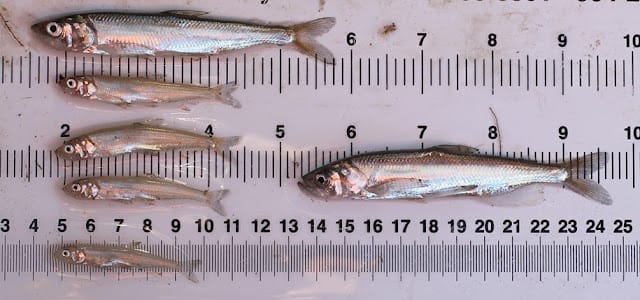Feds propose listing of San Francisco Bay-Delta longfin smelt as endangered species

Sacramento, CA.— The U.S. Fish and Wildlife Service on October 6 proposed the listing of the San Francisco Bay-Delta distinct population segment of longfin smelt as an “endangered” species under the Endangered Species Act (ESA).
The population of the once abundant species, a cousin of the endangered Delta smelt, has declined dramatically in recent years.
”Scientific analysis shows the Bay-Delta longfin smelt is in danger of extinction throughout its range,” the service said in a statement. The Service is now seeking public comment for 60 days after publication on the proposed rule in the Federal Register.
The announcement follows a petition and three lawsuits filed by the Center for Biological Diversity and San Francisco Baykeeper on behalf of the fish. The groups said the agency delayed identification and protection of critical habitat, which will require future action by the groups.
The Service said it has completed a “thorough review of the Bay-Delta population of longfin smelt, its habitat and current threats to determine whether ESA protections are warranted.”
Habitat loss due to the long-term reduction and alteration of freshwater flows into the San Francisco Bay estuary — driven by water diversions from Central Valley rivers and water exports south of the Delta by the State Water Project and Central Valley Project — is cited as the primary threat. Longfin smelt require specific water temperatures and adequate freshwater flows to survive, the Service said.
Between 1967 and 2020, the CDFW’s Fall Midwater Trawl Abundance for longfin smelt has declined by 99.96 percent, according to an analysis of CDFW data in 2021 by Bill Jennings, executive director of the California Sportfishing Protection Alliance (CSPA).
“The longfin smelt may be small and unassuming, but they are an important part of the Bay-Delta estuary. The loss of this species would have a ripple effect throughout the ecosystem,” said Paul Souza, the Service’s Pacific Southwest Regional Director.
“If this species is listed, the Service will work with partners to balance the needs of the species and communities that depend on Bay-Delta water resources. Additional funding for recovery actions can also be made available through the Service and our partners for continued conservation of the fish in California,” Sousa noted.
Souza said potential recovery actions include “habitat restoration, research, captive propagation and reintroduction, and outreach and education.” Listing would also require federal agencies to consult with the Service when proposing projects within the Bay-Delta longfin smelt’s range and would enable the designation of critical habitat under the ESA.
Water diversions from rivers feeding the bay are unsustainable
In response to the proposed listing, Jon Rosenfield, Ph.D., senior scientist for San Francisco Baykeeper and a recognized expert on longfin smelt ecology, said, “Our local longfin smelt population is particularly sensitive to changes in the volume of fresh water flowing into San Francisco Bay. The longfin smelt’s catastrophic decline is yet another sign that water diversions from the rivers that feed the bay are unsustainable.”
He noted that protections for this endangered species have been denied for almost 30 years — and urged the federal and state governments to act quickly to implement new safeguards for this unique species, as well as for the rest of San Francisco Bay’s native fish and wildlife.
Rosenfield said longfin smelt were once one of the most abundant fishes in the San Francisco Bay estuary, which includes the Sacramento-San Joaquin River Delta. They’re a key part of the food web, acting as a prey base that supports commercial and recreational fisheries and wildlife.
“But annual state surveys reveal that longfin smelt in San Francisco Bay have been at or near record low abundance almost every year since 2007 — and the species is nearly undetectable in other Northern California estuaries,” according to Rosenfield.
“This is a hugely important species whose decline highlights the potential loss of the bay’s native fish and fisheries,” said Jeff Miller, a senior conservation advocate at the Center. “Wildlife officials have dawdled and refused to protect longfin smelt for a quarter century. Meanwhile, more and more water diversions suck the life out of Central Valley rivers and the delta to benefit corporate agribusiness and development.”
Miller said poor management of Central Valley tributary rivers, including construction and operation of hundreds of dams and thousands of water diversions, has slashed annual freshwater flow into the Bay by 53% — and by more than 70% in the critical winter-spring period in some recent years.
“This massive overuse of limited freshwater resources — largely by industrial agribusiness — results in perpetual, man-made, drought-like conditions for native fish, which degrades their habitat,” said Miller.
Delta Tunnel will only increase threat of extinction of longfin smelt and other species
Miller said extended climatic drought and water mismanagement have caused an “unprecedented water crisis” in California — and noted that the state’s plan to divert additional fresh water from the Delta, the Delta Conveyance Project, AKA Delta Tunnel, would cause even more damage.
In July the California Department of Water Resources released a revised environmental impact report for the Delta Conveyance Project. The new plan would add a water diversion in the lower Sacramento River and a tunnel to carry the water under the Delta for cities and agribusiness south of the Delta, noted Miller.
“This will increase the threat of extinction for many native fish species, including longfin smelt, delta smelt, winter-run Chinook salmon, spring-run Chinook salmon, Central Valley steelhead and green sturgeon. The announced price tag for the new tunnel is $16 billion, but in reality it will likely cost taxpayers up to $40 billion,” he concluded.
The longfin smelt is 3.5 to 4.3 inches long with a translucent silver appearance on its sides and gut, while its back has an olive to iridescent pinkish hue, according to the Service. The fish lives about two to three years, in bays and estuaries along the coast from Northern California to Alaska.
The Bay-Delta longfin smelt occupies only the San Francisco Bay Estuary and areas of the Pacific Ocean out to the Farallon Islands. Bay-Delta longfin smelt are anadromous, meaning older juveniles and adults can migrate to the ocean, but must return to fresh water to spawn.
Longfin smelt are currently listed as a threatened species under California’s Endangered Species Act that prohibits unpermitted possession, purchase, sale or take of listed species. However, the state’s definition of take does not include harm, which under the federal ESA can include destruction of habitat.
The collapse of longfin smelt in the San Francisco Bay-Delta Estuary occurs in the context of the overall collapse of the estuary’s pelagic fish species, as documented in the State’s Fall Midwater Trawl surveys.
Between 1967 and 2020, the state’s Fall Midwater Trawl abundance indices for striped bass, Delta smelt, longfin smelt, American shad, splittail and threadfin shad have declined by 99.7, 100, 99.96, 67.9, 100, and 95%, respectively, reported Bill Jennings, executive director of the California Sportfishing Protection Alliance.
“Taken as five-year averages (1967-71 vs. 2016-20), the declines for striped bass, Delta smelt, longfin smelt, American shad, splittail and threadfin shad are 98.1, 99.8, 99.8, 26.2, 99.3 and 94.3 percent, respectively,” Jennings said.
How to comment on the proposed rule
The proposed rule will publish in the Federal Register on October 7, 2022. Comments will be accepted until December 6, 2022. Requests for public hearings must be submitted in writing no later than November 21, 2022.
Information on how to submit comments is available at www.regulations.gov by searching under docket number: FWS-R8-ES-2022-0082.
You can also submit comments and information, or a hearing request in writing to: Public Comments Processing, Attn: FWS-R8-ES-2022-0082, U.S. Fish and Wildlife Service, MS: PRB/3W, 5275 Leesburg Pike, Falls Church, VA 22041–3803.
Background from the San Francisco Baykeeper and Center for Biological Diversity:
Conservation groups first petitioned for the longfin smelt (Spirinchus thaleichthys) to be protected under the Endangered Species Act in 1994, but the Service refused to conduct a status review for the species.
The Center for Biological Diversity, San Francisco Baykeeper and other conservation organizations submitted another petition for the San Francisco Bay-Delta population of longfin smelt in 2007, which the Service denied in 2009. The Center and The Bay Institute challenged the finding in a lawsuit. The Service then initiated a status review, finding in 2012 that the San Francisco Bay population of longfin smelt is in fact distinct and that it does warrant protection under the Endangered Species Act.
Rather than provide those long-delayed protections, the agency instead added longfin smelt to a federal waiting list, where species often spend years or decades waiting for the Service to take action. The Center and San Francisco Baykeeper each filed lawsuits challenging the nearly 30-year delay in providing protection to San Francisco Bay’s longfin smelt



